 Following the latest research in the field of obtaining single-molecule magnets, scientists have taken another step on the way toward obtaining super-dense magnetic memories and molecular neural networks, in particular the construction of auto-associative memories and multi-criterion optimization systems operating as the model of the human brain.
Following the latest research in the field of obtaining single-molecule magnets, scientists have taken another step on the way toward obtaining super-dense magnetic memories and molecular neural networks, in particular the construction of auto-associative memories and multi-criterion optimization systems operating as the model of the human brain.
Tuesday, March 3, 2020
Obtaining and observing single-molecule magnets on the silica surface
 Following the latest research in the field of obtaining single-molecule magnets, scientists have taken another step on the way toward obtaining super-dense magnetic memories and molecular neural networks, in particular the construction of auto-associative memories and multi-criterion optimization systems operating as the model of the human brain.
Following the latest research in the field of obtaining single-molecule magnets, scientists have taken another step on the way toward obtaining super-dense magnetic memories and molecular neural networks, in particular the construction of auto-associative memories and multi-criterion optimization systems operating as the model of the human brain.
Magnetic whirls in future data storage devices
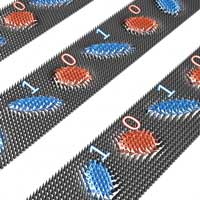 Scientists observed that skyrmions and antiskyrmions can coexist, bringing about the possibility to expand their capabilities in storage devices.
Scientists observed that skyrmions and antiskyrmions can coexist, bringing about the possibility to expand their capabilities in storage devices.
Scientists created the first diamond x-ray micro lens
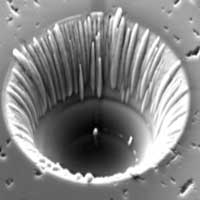 The thinner-than-human-hair lenses may be used for in the most powerful synchrotrons and x-ray lasers.
The thinner-than-human-hair lenses may be used for in the most powerful synchrotrons and x-ray lasers.
New DNA origami motor breaks speed record for nano machines
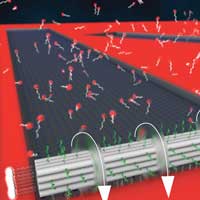 Through a technique known as DNA origami, scientists have created the fastest, most persistent DNA nano motor yet. The findings provide a blueprint for how to optimize the design of motors at the nanoscale.
Through a technique known as DNA origami, scientists have created the fastest, most persistent DNA nano motor yet. The findings provide a blueprint for how to optimize the design of motors at the nanoscale.
Technology provides a new way to probe single molecules
 Precision measurements can aid understanding of disease, infection and vaccines.
Precision measurements can aid understanding of disease, infection and vaccines.
Wearable thermal camouflage device works in any weather (w/video)
 Researchers have developed a wearable technology that can hide its wearer from heat-detecting sensors such as night vision goggles, even when the ambient temperature changes - a feat that current state of the art technology cannot match.
Researchers have developed a wearable technology that can hide its wearer from heat-detecting sensors such as night vision goggles, even when the ambient temperature changes - a feat that current state of the art technology cannot match.
New process for creating nanoarchitected materials
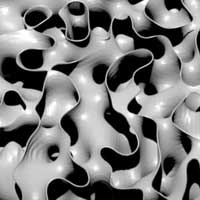 A new process makes it possible for the first time to manufacture large quantities of materials whose structure is designed at a nanometer scale - the size of DNA's double helix.
A new process makes it possible for the first time to manufacture large quantities of materials whose structure is designed at a nanometer scale - the size of DNA's double helix.
Atomic-scale imaging reveals secret to thin-film strength
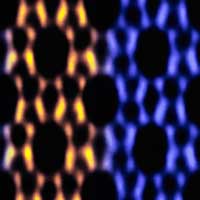 Breakthrough discovery pushes limits of microscopy to improve efficiency of fuel and plastic production.
Breakthrough discovery pushes limits of microscopy to improve efficiency of fuel and plastic production.
Joint venture at the nanoscale - when superconductivity material science meets nuclear physics
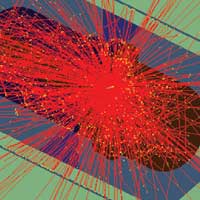 Scientists report fabricating and testing a superconducting nanowire device applicable to high-speed photon counting for nuclear physics experiments that were previously thought impossible. This device operates at temperatures near to absolute zero in magnetic fields forty times stronger than previous such devices and is able to detect low-energy photons as well as other fundamental particles.
Scientists report fabricating and testing a superconducting nanowire device applicable to high-speed photon counting for nuclear physics experiments that were previously thought impossible. This device operates at temperatures near to absolute zero in magnetic fields forty times stronger than previous such devices and is able to detect low-energy photons as well as other fundamental particles.
Scientists pair machine learning with tomography to learn about material interfaces
 Researchers have put a new technique based on machine learning to work uncovering the secrets of buried interfaces and edges in a material. By using machine learning as an image processing technique, scientists can dramatically accelerate the heretofore laborious manual process of quantitatively looking at interfaces without having to sacrifice accuracy.
Researchers have put a new technique based on machine learning to work uncovering the secrets of buried interfaces and edges in a material. By using machine learning as an image processing technique, scientists can dramatically accelerate the heretofore laborious manual process of quantitatively looking at interfaces without having to sacrifice accuracy.
Graphene, perovskites, and silicon - an ideal tandem for efficient solar cells
 Researchers have successfully combined graphene with tandem perovskite-silicon solar cells to achieve efficiencies of up to 26.3%. Moreover, they envisioned a new manufacturing method that, thanks to the versatility of graphene, allows to reduce production costs and could lead to the production of large-area solar panels.
Researchers have successfully combined graphene with tandem perovskite-silicon solar cells to achieve efficiencies of up to 26.3%. Moreover, they envisioned a new manufacturing method that, thanks to the versatility of graphene, allows to reduce production costs and could lead to the production of large-area solar panels.
Subscribe to:
Comments (Atom)
